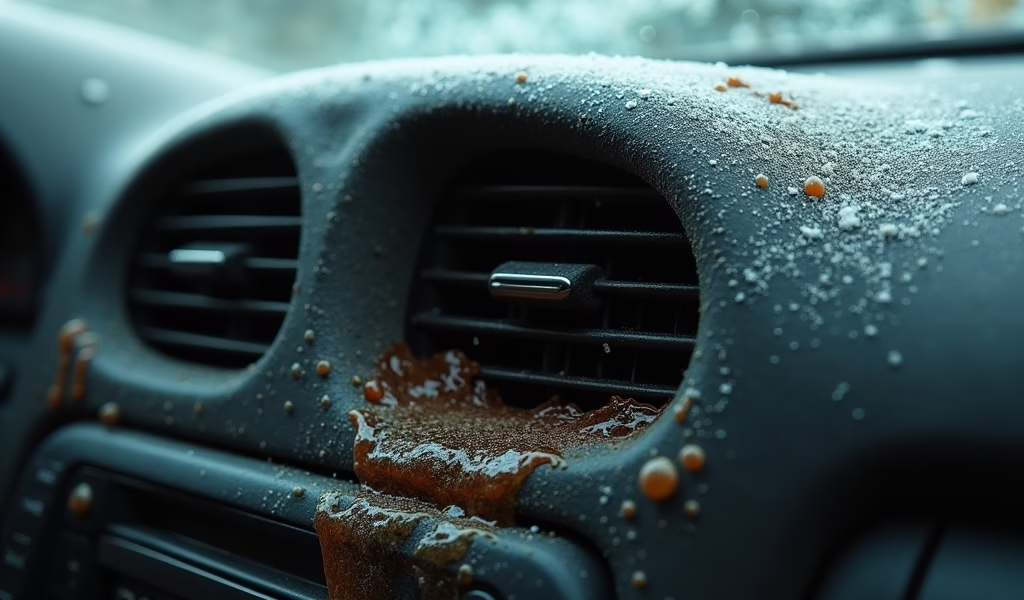Overview
This article provides expert advice on car AC maintenance, covering system components, warning signs of problems, DIY maintenance tips like filter replacement, and guidance on when professional service is needed. It emphasizes that regular maintenance extends AC lifespan, improves driving comfort and safety, and helps avoid costly repairs through preventive care.
Table of Contents
- Understanding Your Car’s AC System
- Warning Signs Your AC Needs Attention
- DIY Car AC Maintenance Tips
- When to Get Professional AC Service
- Extending Your AC System’s Lifespan
- Troubleshooting Common AC Problems
- Conclusion
- Frequently Asked Questions
When the mercury rises and your commute turns into a mobile sauna, nothing feels more like a modern miracle than that first blast of cold air from your car’s AC. As a certified automotive technician with 15 years of experience, I’ve seen countless drivers neglect their vehicle’s cooling system until that miracle suddenly vanishes on the hottest day of summer.
Car air conditioning maintenance isn’t just about comfort—it’s an essential part of your vehicle’s overall health. A well-maintained AC system improves driving safety by keeping you alert and comfortable, protects your dashboard from heat damage, and can even improve fuel efficiency compared to driving with windows down at highway speeds.
In this guide, I’ll share the professional secrets that can keep your car’s AC blowing cold for years to come, potentially saving you hundreds in unnecessary repairs. These tips work for virtually any make or model, from budget-friendly compacts to luxury SUVs.
Understanding Your Car’s AC System
Your car’s air conditioning isn’t magic, though it might feel like it on a 95-degree day. The system works on the basic principle of heat transfer, moving warmth from inside your vehicle to the outside.
The main components include the compressor (the heart of the system), condenser, evaporator, expansion valve, and refrigerant. When you press that snowflake button, the compressor pressurizes the refrigerant, starting a cycle that ultimately results in cold air flowing through your vents.
Modern vehicles use R-134a or R-1234yf refrigerant, which are vastly different from the older R-12 refrigerant (Freon) that was phased out due to environmental concerns. This evolution in refrigerant technology is why professional certification is required to handle these systems—they’re more complex than they appear.

Warning Signs Your AC Needs Attention
Your car’s AC will usually give you plenty of warning before it fails completely. Learning to recognize these signals can save you from sweating through your shirt on your next summer drive.
Reduced Cooling Performance
If your AC isn’t cooling like it used to, don’t ignore it. When the air from your vents feels more like a warm breath than a cold breeze, it typically indicates low refrigerant levels, often due to a slow refrigerant leak somewhere in the system.
Unusual Noises
Your AC should operate with minimal noise. Squealing often indicates a worn belt, while rattling or knocking could mean trouble with the compressor or blower motor. Unusual sounds almost always mean something’s loose, worn, or about to fail.
Strange Odors
That musty smell when you first turn on your AC isn’t normal—it’s usually mold or bacteria growing in your evaporator or ducts. Beyond being unpleasant, these microorganisms can trigger allergies and respiratory issues, especially in children or those with compromised immune systems.
Water Inside the Vehicle
While some condensation dripping under your parked car is normal, water inside your vehicle indicates a clogged drain tube. This seemingly minor issue can lead to electrical problems, carpet damage, and even dangerous mold growth if left unaddressed.
DIY Car AC Maintenance Tips
Not every AC issue requires a trip to the repair shop. These DIY maintenance steps can help keep your system running smoothly without breaking the bank.
Replace Cabin Air Filters Regularly
Your cabin air filter is the unsung hero of your AC system. It traps pollen, dust, and debris before they can enter your vehicle’s interior. Most manufacturers recommend replacing this filter every 15,000-30,000 miles, but I suggest changing it yearly if you drive in dusty conditions or suffer from allergies.
Replacing the filter is usually simple:
- Locate the filter (typically behind the glove box or under the dashboard)
- Remove any cover or access panel
- Note the direction the old filter faces before removing it
- Install the new filter in the same orientation
- Replace any covers and close the compartment
A clean filter improves airflow, reduces strain on your blower motor, and provides cleaner air for everyone in your vehicle.
Clean Air Vents and Ducts
Over time, dust accumulates in your vents and ductwork. Use a small brush (like a clean paintbrush) to dust visible vents, followed by a vacuum with a narrow attachment. For deeper cleaning, consider using compressed air to blow out debris.
For persistent odors, specialized foam cleaners designed for automotive AC systems can help eliminate bacteria and mold. Simply spray into the external air intake (typically located near the base of your windshield) with the AC fan running on high.
Run Your AC Year-Round
One of the simplest yet most effective maintenance tips is to run your AC for at least 10 minutes every week, even during winter. This keeps the seals lubricated and prevents the refrigerant from settling. It also helps prevent mold growth by keeping components dry.
During colder months, you can run the AC simultaneously with your heater—this dehumidifies the air and helps prevent foggy windows while maintaining the system’s health.
Keep the Condenser Clean
Your condenser sits at the front of your vehicle (usually in front of the radiator) and looks similar to a small radiator. It needs good airflow to function properly.
Periodically check for debris like leaves, bugs, or road grime that might be blocking the fins. A gentle spray with a garden hose (not a pressure washer) can remove most buildup. Always spray from the back toward the front to avoid pushing debris deeper into the fins.
When to Get Professional AC Service
While DIY maintenance is valuable, some AC issues require professional attention. Knowing when to call in the experts can save you time, money, and frustration.
Refrigerant Handling
Never attempt to recharge or handle refrigerant yourself unless you’re certified. Modern automotive refrigerants require special equipment for proper handling, and incorrect procedures can damage your system or pose environmental hazards. Additionally, those “quick fix” refrigerant cans at auto parts stores often contain sealer that can clog delicate components.
A proper professional recharge includes:
- Recovering remaining refrigerant (never venting to atmosphere)
- Vacuum testing to check for leaks
- Adding the exact amount of refrigerant specified for your vehicle
- Performance testing after service
Schedule Regular Professional Inspections
Have your AC system professionally inspected every 2-3 years as part of your regular vehicle maintenance. A trained technician can spot early warning signs of wear or damage before they become major problems. They’ll check pressures, inspect components, and test performance—tasks beyond most DIYers.
This preventive approach typically costs $100-200 but can prevent major repairs that often exceed $1,000. Consider scheduling these inspections in early spring, before repair shops get swamped with emergency AC repairs.
Compressor Issues
The compressor is both the heart and the most expensive component of your AC system. If your compressor is making unusual noises, failing to engage, or has visible damage, seek professional help immediately. Continuing to run a failing compressor can spread metal debris throughout your entire system, potentially turning a single component replacement into a complete system overhaul.

Extending Your AC System’s Lifespan
Beyond basic maintenance, these professional strategies can significantly extend the life of your car’s AC system, potentially adding years of trouble-free operation.
Pre-Cooling Strategies
The hardest your AC ever works is when cooling down a scorching hot vehicle. Reduce this strain with simple pre-cooling techniques:
- Use windshield sunshades when parking in direct sunlight
- Crack windows slightly when safe to do so (allows the hottest air to escape)
- Use remote start (if equipped) to begin cooling before entering
- Open doors and windows for 30 seconds before turning on the AC
- Park in shade whenever possible
These steps reduce the initial thermal load, meaning your system doesn’t have to work as hard to achieve comfortable temperatures.
Optimal Settings for Efficiency
How you operate your AC affects its longevity. For maximum efficiency and component life:
- Start with the fan on high, then reduce to medium once the cabin begins cooling
- Use the recirculation button when first cooling (recycles already-cooled air)
- Switch to fresh air mode after initial cooldown to prevent window fogging
- Avoid setting the temperature to the absolute coldest setting
- Turn off the AC (but leave the fan running) a few minutes before reaching your destination
These habits reduce stress on your compressor and help prevent moisture buildup in the system.
Address Small Issues Promptly
In my years as a technician, I’ve seen countless $150 repairs turn into $1,500 overhauls because drivers postponed addressing minor symptoms. If you notice reduced cooling, strange noises, or unusual odors, don’t wait for the problem to worsen.
Small refrigerant leaks, when caught early, often require minimal repair. Allow them to continue, and you’ll eventually run the compressor without enough lubricant, potentially causing catastrophic failure.
Troubleshooting Common AC Problems
When your AC isn’t performing properly, these troubleshooting steps can help identify the issue before you seek professional help.
AC Blows Warm Air
If your AC is blowing warm air, first check the obvious: make sure the AC button is actually engaged (not just the fan) and that the temperature control is set correctly. Next, look at your engine temperature gauge—an overheating engine will often cause the AC to shut down as a protective measure.
If those checks don’t solve the issue, you’re likely dealing with low refrigerant, a failed compressor, or an electrical problem. These typically require professional diagnosis using specialized equipment.
Weak Airflow
Poor airflow usually stems from one of four issues:
- Clogged cabin air filter (most common and easiest to fix)
- Debris blocking the exterior air intake
- Failing blower motor
- Mold buildup on the evaporator restricting airflow
Start by replacing the cabin filter. If airflow remains weak, check that the intake at the base of your windshield isn’t blocked by leaves or debris. Persistent weak airflow, especially if accompanied by unusual noises, often indicates blower motor issues requiring professional attention.
Eliminating Unpleasant Odors
That musty smell isn’t just unpleasant—it indicates mold or bacteria in your system. Beyond replacing the cabin air filter, you can use specialized AC cleaning products that kill mold and bacteria on the evaporator.
For a quick DIY approach, try running the fan on high (without AC) for about 10 minutes before turning off your car. This helps dry the evaporator, making it less hospitable to microorganisms. For persistent odors, professional evaporator cleaning may be necessary.
AC Cycles On and Off Rapidly
If your compressor is engaging and disengaging rapidly (every few seconds), you’re likely dealing with:
- Low refrigerant level
- A faulty cycling switch
- Excessive system pressure
This cycling puts extreme stress on your compressor and should be addressed promptly by a professional. Continuing to operate the system in this condition can cause premature compressor failure.
Conclusion
Your car’s air conditioning is more than a luxury—it’s an essential system that affects your comfort, safety, and vehicle longevity. With proper car air conditioning maintenance, most systems can provide reliable service for many years, even in the most challenging climates.
The most effective approach combines regular DIY maintenance with occasional professional service. Replace filters, keep components clean, address small issues promptly, and have the system professionally inspected every few years as part of your essential car maintenance routine.
Remember that an ounce of prevention truly is worth a pound of cure when it comes to automotive AC systems. The small investment of time and money in preventive maintenance can help you avoid costly repairs and ensure you stay cool no matter how hot it gets outside.
Frequently Asked Questions
How often should I recharge my car’s AC system?
A properly functioning AC system shouldn’t need regular recharging. If your system requires frequent recharging, you likely have a leak that should be diagnosed and repaired.
Can I use DIY refrigerant recharge kits from auto parts stores?
I don’t recommend DIY recharge kits as they often contain sealants that can damage your AC system components. These products may provide temporary cooling but can cause expensive damage long-term.
Why does my car AC smell bad when I first turn it on?
That musty smell is typically caused by mold and bacteria growing on your evaporator core or in your air ducts. Replace your cabin air filter and consider using an AC system cleaner designed to eliminate these microorganisms.
Does running the AC waste a lot of fuel?
Modern AC systems are quite efficient and typically impact fuel economy by only 1-4 mpg. At highway speeds, using AC is often more fuel-efficient than driving with windows down, which creates aerodynamic drag.
How much does professional AC service typically cost?
Basic AC inspection and service typically costs $100-200, while major repairs like compressor replacement can range from $800-1,500 depending on your vehicle. Regular maintenance is always less expensive than emergency repairs.

